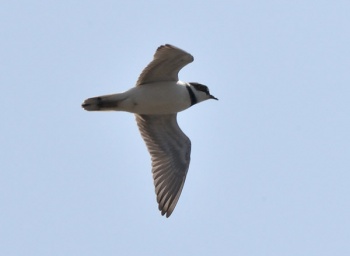(Video linked, Vocalisation heading & and Categories added) |
(Flight photo added. Some deleted text replaced. Attempt to clean up some copied text, referenced) |
||
| Line 3: | Line 3: | ||
==Identification== | ==Identification== | ||
| − | + | 17cm<br /> | |
| + | *Greyish-brown back and wings, | ||
| + | *White belly and breast | ||
| + | *Black neckband | ||
| + | *Brown cap | ||
| + | *White forehead and supercillium | ||
| + | *Black facial mask | ||
| + | *Yellow eye ring | ||
| + | *Short dark bill | ||
| + | *Flesh-coloured legs. | ||
| + | ====Similar Species==== | ||
| + | A very similar species to the ''slightly'' larger [[Common Ringed Plover]]. The most obvious differences are the yellow eye ring and all black bill in the Little Ringed Plover. Its legs are also reddish compared with the orange legs of the Common Ringed Plover. | ||
==Distribution== | ==Distribution== | ||
| − | [[Eurasia]], [[Africa]] and [[Australasia]]. | + | [[Image:LRP DSC3342crop.jpg|thumb|350px|right|Photo by {{user|Stoop|Stoop}}<br />Toyano, Niigata, [[Japan]]]] |
| + | |||
| + | [[Eurasia]], [[Africa]] and [[Australasia]]. Rare breeder in [[Scotland]] | ||
==Taxonomy== | ==Taxonomy== | ||
====Subspecies<sup>[[#References|1]]</sup>==== | ====Subspecies<sup>[[#References|1]]</sup>==== | ||
| − | *''C. d. curonicus'' - breeds Palearctic; winters to Africa, Arabia, e China and Indonesia | + | *''C. d. curonicus'' - breeds [[Palearctic]]; winters to [[Africa]], [[Arabia]], e [[China]] and [[Indonesia]] |
| − | *''C. d. jerdoni'' - India and SE Asia | + | *''C. d. jerdoni'' - [[India]] and SE [[Asia]] |
| − | *''C. d. dubius'' - Philippines to New Guinea and Bismarck Archipelago | + | *''C. d. dubius'' - [[Philippines]] to [[New Guinea]] and [[Bismarck Archipelago]] |
==Habitat== | ==Habitat== | ||
Freshwater, gravel pits, islands and river edges. | Freshwater, gravel pits, islands and river edges. | ||
==Behaviour== | ==Behaviour== | ||
| + | ====Breeding==== | ||
They nest on the ground on stones with little or no plant growth. | They nest on the ground on stones with little or no plant growth. | ||
| − | + | ====Diet==== | |
These birds forage for food on muddy areas, and the diet includes insects and worms. | These birds forage for food on muddy areas, and the diet includes insects and worms. | ||
====Vocalisation==== | ====Vocalisation==== | ||
| Line 22: | Line 36: | ||
==References== | ==References== | ||
# Clements, James F. 2007. ''The Clements Checklist of Birds of the World''. 6th ed., with updates to October 2008. Ithaca: Cornell University Press. ISBN 9780801445019 | # Clements, James F. 2007. ''The Clements Checklist of Birds of the World''. 6th ed., with updates to October 2008. Ithaca: Cornell University Press. ISBN 9780801445019 | ||
| + | #Wikipedea | ||
| + | #Collins Field Guid 5th Edition | ||
==External Links== | ==External Links== | ||
{{GSearch|Charadrius+dubius}} | {{GSearch|Charadrius+dubius}} | ||
Revision as of 11:14, 18 March 2009

- Charadrius dubius
Identification
17cm
- Greyish-brown back and wings,
- White belly and breast
- Black neckband
- Brown cap
- White forehead and supercillium
- Black facial mask
- Yellow eye ring
- Short dark bill
- Flesh-coloured legs.
Similar Species
A very similar species to the slightly larger Common Ringed Plover. The most obvious differences are the yellow eye ring and all black bill in the Little Ringed Plover. Its legs are also reddish compared with the orange legs of the Common Ringed Plover.
Distribution
Eurasia, Africa and Australasia. Rare breeder in Scotland
Taxonomy
Subspecies1
- C. d. curonicus - breeds Palearctic; winters to Africa, Arabia, e China and Indonesia
- C. d. jerdoni - India and SE Asia
- C. d. dubius - Philippines to New Guinea and Bismarck Archipelago
Habitat
Freshwater, gravel pits, islands and river edges.
Behaviour
Breeding
They nest on the ground on stones with little or no plant growth.
Diet
These birds forage for food on muddy areas, and the diet includes insects and worms.
Vocalisation
<flashmp3>Charadrius dubius (song).mp3</flashmp3>
Listen in an external program
References
- Clements, James F. 2007. The Clements Checklist of Birds of the World. 6th ed., with updates to October 2008. Ithaca: Cornell University Press. ISBN 9780801445019
- Wikipedea
- Collins Field Guid 5th Edition
External Links




